The picture shows the inauguration of the "Stone of Encounter" in the fall of 2012
Chapter: Project / Stone of Encounter
The Quest for a Deeper Understanding
In a world often characterized by conflicts and misunderstandings, the question of the nature of peace and freedom arises with particular urgency. This text takes you on a journey of discovery that begins at the
Stone of Encounter. This journey takes us through various considerations of borders, culture, and history, and extends beyond the specific context of German history. It shows us that peace and freedom are more than mere words; they are universal ideals that should shape our actions and our coexistence worldwide.The Stone of Encounter, with the inscription 'Yerushalayim…', the 'Heavenly Jerusalem', and its universal message, is rooted in German history and thus in the trauma of German-Jewish relations, but it reflects a global concern: the search for peace and freedom everywhere in the world. A universal message must be anchored in the concrete to be effective, and this is precisely what the Stone of Encounter does – it connects the local with the global, the personal with the universal. Here you can learn more about the name Jerusalem, the historical context of 'Jerusalem on the Rhine', and the connection between 'Jerusalem' and freedom of speech in Germany.
Greeting by Rabbi Andrew Steiman on the inauguration of the Stone of Encounter: 'Jerusalem is more than a place, Jerusalem is a state of beauty. Jerusalem is everywhere there is beauty. Now there is something of it in Bensheim; and Bensheim can also be in Jerusalem, if it wishes. To reach the Jerusalem from above, one must go through the Jerusalem from below. This possibility is now available to everyone in Bensheim… more" This universal 'Idea of Jerusalem' reminds us that the quest for peace and beauty is a common human longing.
Symbol and Message of the Stone of EncounterThe inscription "
YERUSHALAYIM - 3000 km " on the Stone of Encounter at the border of the European Long-Distance Path E8 is more than just a geographical marker; it is "A cry full of love for freedom for mankind. That we recognize the fences in our togehterness…" This call encourages us to recognize the fences in our interactions. The inscription emphasizes the importance of boundaries for external peace and coexistence and reminds us that true freedom and encounter require a framework of respect and regard. Without protecting and recognizing the sacred in our lives, it loses both its strength and beauty.
The name Yerushalayim (Jerusalem, foundation of peace) was deliberately chosen. It serves as a reconciling confession (Numbers 24:9) to a root of our culture that extends from Christianity into Judaism, anchoring values of the Torah within it, such as the Ten Commandments. However, the significance of Yerushalayim goes beyond religious concepts. It symbolizes a universal idea of life: It is as if one awakens from a dark dream and finds oneself in a world where people live in peace, freedom, and goodwill towards each other; a world filled with beauty, hope, and light. This ideal of Yerushalayim challenges us to think beyond cultural and religious boundaries and to heal the 'wounded root' of Yerushalayim in our own cultural context – in this case, in Germany.
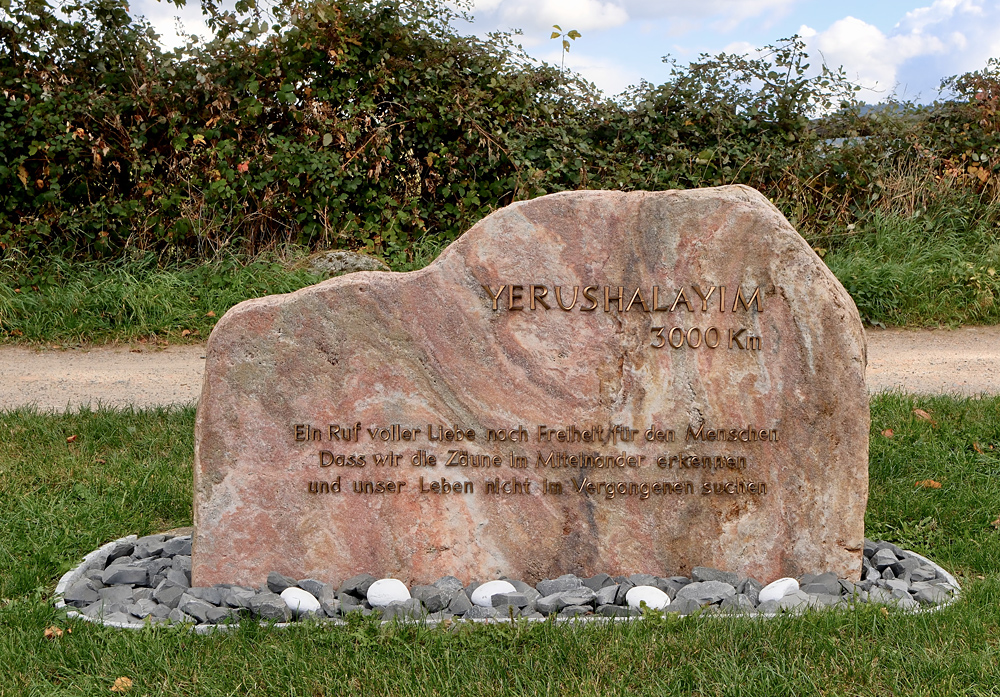
A Stone on the Hiking Trail
The
Stone of Encounter is located along a hiking trail. It serves as a metaphor for the path of experiences in life. The Stone of Encounter represents the encounter with the world, including confrontations with pain and the sorrows of life. At the same time, it symbolizes the hope that one may hold onto their journey, to not give up due to disappointments, personal or others’ failures, envy, and lies; to not succumb to a burden felt as overwhelming; to be able to continue on despite these challenges.The Importance of Boundaries
In our vision of a new world, where everyone can contribute their individual beauty and closeness between people prevails, healthy boundaries play a crucial role. These boundaries enable us not to lose ourselves and to maintain our identities. They help us to protect values and the diversity of ideas and structures. Matter itself is defined by structure and limitation. Without delineation, there is no defined life. The more a culture is spiritualized, the more its inner values and healthy boundaries are realized, the less need there is for external demarcations. Yet, there always remains a natural delineation of culture to the outside.
A Heavenly Jerusalem on Earth
The concept of a 'heavenly Jerusalem on Earth' cannot be realized by merely tearing down fences. Boundaries are a part of human experience, as humans are limited in their capabilities. Striving for complete absence of boundaries can lead to overestimation of oneself and inadvertently cause more conflicts. However, recognizing and respecting the diversity in how we perceive the world can free us from considering our own perspective as a universally valid ideology. This process forms the foundation of a culture of freedom.
Only Together—The Peaceful Handling of Boundaries
Only through mutual agreement and togetherness can boundaries (fences) be meaningfully overcome. Overcoming, however, does not mean completely tearing down or ignoring boundaries. There is a peaceful way of dealing with boundaries, which begins with inner reflection. The path of peace, which starts within us, leads us back out into the responsibility for the world.
The events not only in Germany, especially since the year 2015, but also worldwide demonstrate the need for healing cultural roots and establishing a culture of freedom that originates from within and extends beyond national borders. In our interconnected world, decisions and developments in one country often affect other regions. Exchange across borders can help us find common solutions for global problems and strengthen the spirit of peace and freedom worldwide.
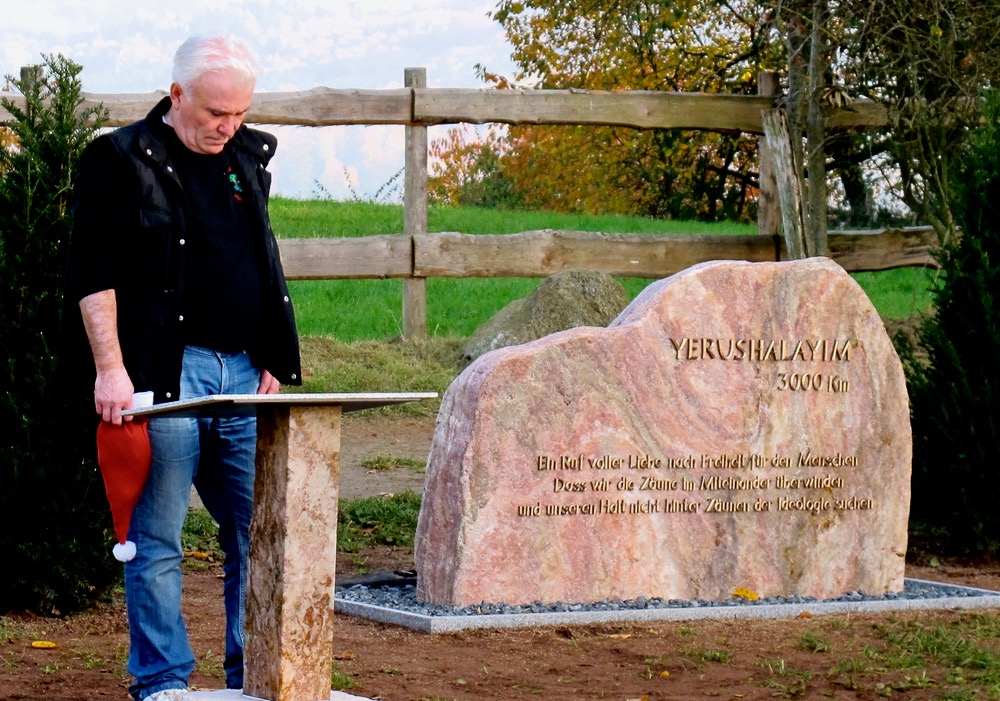
First version of the 'Stone of Encounter', the 'Border Stone"
The Origin of the Stone of Encounter
The Fence Around the Stone
Make a fence around the law' – this guiding principle from the 'Ethics of the Fathers' (Chapter 1, Verse 1) in Judaism unexpectedly found its way into the design of the Friedensmal. In Judaism, the law, the Torah, is called a Tree of Life. In the Friedensmal, the Tree of Life is the central element. The Garden of Freedom and the fence in front of the Stone of Encounter form the framework around the Friedensmal, or the fence around the law. The word 'garden' originates from the Indo-European word 'Ghorto', meaning enclosure. Originally, the 'fence around the law' was not part of the concept of the Friedensmal. Life itself surprisingly brought the fence, and thus the Stone of Encounter and the Garden of Freedom, as the frame of the entire design. This unexpected turn of events illustrates how a person plans their path, but God directs their steps (Proverbs 16:9). The story went like this:
Original Planning
In 2012, the local authorities had issued a special permit for the construction of a horse paddock fence on the neighboring property. Our monument features the
Tree of Life breaking through a dark ring (symbolizing the dark past) towards Jerusalem, thus representing freedom. The new fence was to be erected right in front of the breakthrough of the Tree of Life. However, this contradicted the artistic message of the monument. Additionally, it deprived the originally planned design of the monument, which included 33 large memorial stones, of its freedom to be effective in the intended manner. A monument perceived as oppressive is not suitable for conveying a message of peace and freedom, nor for being attractive to visitors.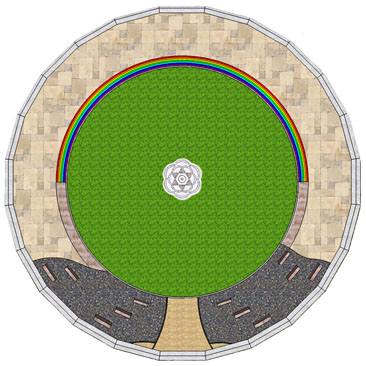
New Perspective
The artist initially omitted 22 large stones from the monument circle and symbolically replaced them, in line with the artistic message of the monument’s design, with the
Engagement with Life
With the
Stone of Encounter and the Garden of Freedom as a frame, it was possible in this way to integrate the fence as a new, clearly visible boundary meaningfully into the design of the monument. It was an artistic response to the problem and ultimately led to a different design that was much more developed both in content and aesthetics. The design thus emerged in a process of engagement with life. At the beginning of 2019, the artist came across the passage 'Make a fence around the law' (Ethics of the Fathers) during an internet search. Life itself had made this directive a reality at the Friedensmal. But there was even more: Interestingly, on the side of the monument facing away from the fence, which was opened for the aforementioned reasons, the historical 'Jerusalem on the Rhine' was later discovered, giving the entire design an additional, deeper meaning.Cultural and Historical Context
Yerushalayim is both a root and a vision, woven into our culture. Throughout history, this root
has been repeatedly injured. To achieve freedom and the full potential of life that we yearn for as individuals and as a society, it is imperative to heal the deep wounds in our own souls and in the collective consciousness. This healing enables us to understand the world more comprehensively and to take responsible actions for today and tomorrow. 'Learning from the past' here means transforming the burdens of the past into hopes and lessons for a better future.The rich Jewish history of our region testifies to a time when Jewish life and culture flourished. Yet this history was overshadowed by tragic events, especially on the night of November 9, 1938, and the following day, when synagogues in many cities, including Speyer, Worms, Mainz, and also in Bensheim, were burned. These events marked the beginning of the systematic destruction of Jewish communities throughout Germany and beyond. The persecution and expulsion of the Jewish Germans is a deep trauma that continues to have an impact today, and its processing and healing are essential for understanding our shared history and shaping our future.
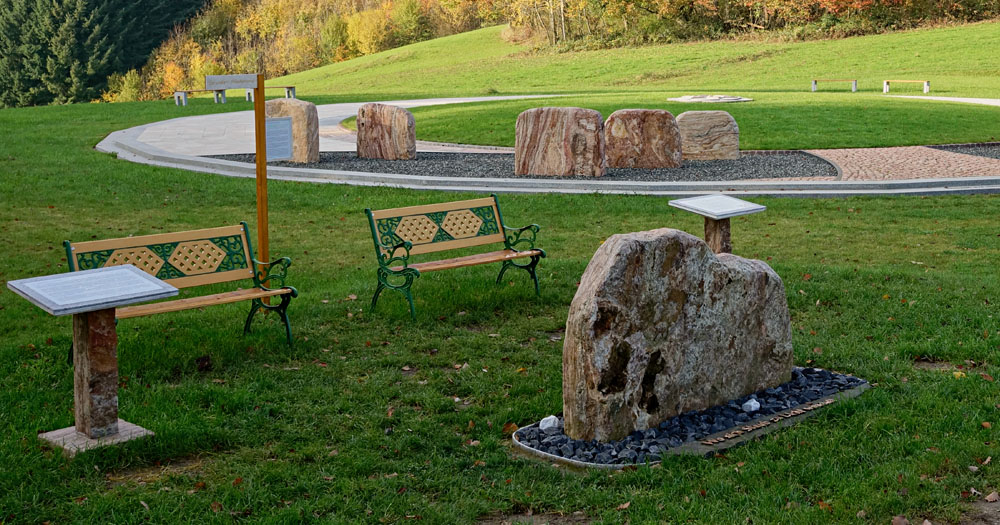
German Past
The raw, unmarked side of the Stone of Encounter faces west towards the Hochstädter Valley – a place with a deep, yet often overlooked history. Since 1865, mining tunnels have shaped the landscape, and during the shadow of World War II, the valley became a site of armaments production, protected from air raids. Tragically, it was displaced Greeks and concentration camp prisoners who were used as forced laborers there. This place thus stands as a silent witness to war, tyranny, and the dark chapter of German history. It was part of a comprehensive system of main and satellite camps that extended across Europe, affecting even small communities like Hochstädten. A detailed account of this history can be found in my treatise, supported by contemporary historical documents.The Stone of Encounter, inscribed with 'Yerushalayim', stands in the Peace Memorial as a cautionary memorial stone. It reminds us not to be ensnared by ideologies and to recognize the boundaries in our interactions. It invites us to reflect on the values embodied by the heavenly Jerusalem. Below the stone is the phrase 'Where dust transforms into light', symbolically pointing to the Friedensmal to the right of the stone. This inscription reminds us that light and understanding can emerge from the darkest chapters of our history – a path of transformation that becomes visible in the Friedensmal.
Hope for Peace
We know that we can never be content in a world where ignorance and hatred overshadow what should be a life filled with beauty, truth, and goodness. Only where there is light can darkness recede, and that is why the name
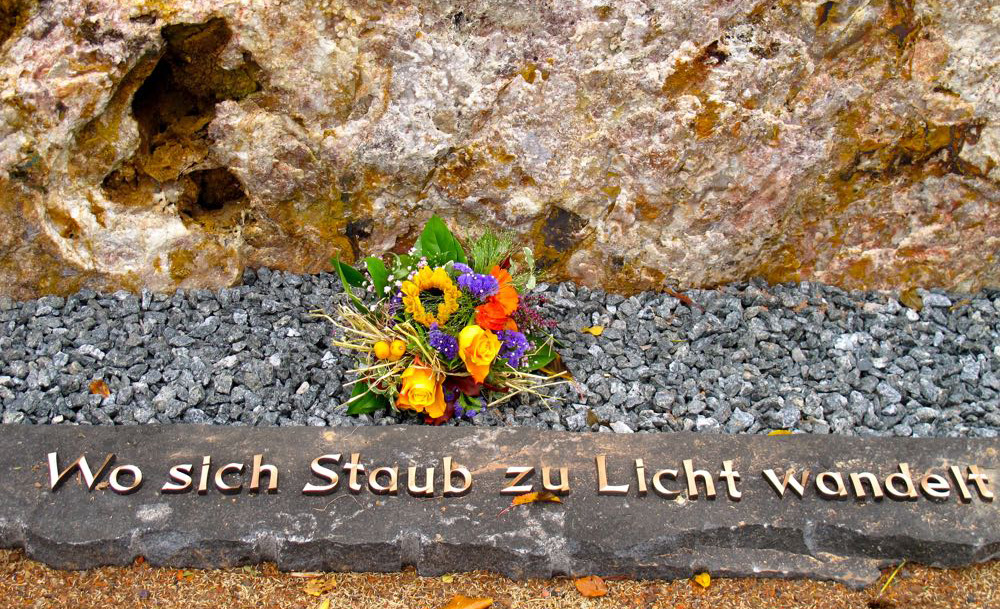
After the horrors of the Shoa and the war, Nelly Sachs, the German-Jewish poet and Nobel Prize in Literature laureate, wrote in a poem: 'You observers, who did not raise a hand to murder, but who did not shake the dust off your longing, who stood there, where it is transformed into light.' This expresses a deep yearning for transformation.
Monuments like the Friedensmal can be an encouragement to engage in peace and freedom and thus learn from the past. Only where there is light can darkness recede. How can we take responsibility for the hope of peace represented by Yerushalayim in the world? Where does our responsibility begin? 'Where dust transforms into light' - this inscription on the ground in front of the Stone of Encounter points to the Tree of Life in the Friedensmal. It's about going to one's own center: Peace and freedom begin in one's inner world.
YERUSHALAYIM is an expression of hope. Humans are not merely material beings in a material world. What defines them is their consciousness. A person's journey through life can also become a process of spiritual awakening. Religions can be facilitators in this, with their structure representing demarcation and order. Religions become a problem when they no longer respect the spiritual path of the individual because they have become walled and closed spaces of religious ideology. The Catholic theologian Karl Rahner wrote about religion: 'The devout of the future will be a 'mystic', one who has 'experienced' something, or he will not be any longer.'

Rabbi Mordechai Mendelson at the Stone of Encounter
Concluding Words: Our Responsibility for Peace and Freedom
This text has illuminated the multifaceted significance and the profound symbolism of the Stone of Encounter and the entire Peace Memorial – from the inscription 'Yerushalayim' as a universal symbol of the longing for peace and freedom, to the importance of boundaries in human interaction, and the consideration of the cultural and historical context, which emphasizes the importance of healing and learning from the past.The central message is clear: Peace and freedom are more than just external states; they arise and grow within us. They are the result of a conscious interaction with ourselves and our environment. We all bear the responsibility to realize these ideals in our lives, thereby making a positive contribution to all of humanity.
Our call to action is therefore unequivocal: Let us take the lessons and the symbolism of the Peace Memorial as a source of inspiration to actively stand for peace and freedom in our own lives and in our communities. Through conscious action and mutual respect, it is possible to shape a world in which the ideals of 'Yerushalayim' are not just a distant hope but a lived and tangible reality.
* "A cry full of love for human freedom. That we overcome the fences in togetherness and do not seek our anchor behind fences of ideology." The stone with this inscription was set in 2012 as the 'Border Stone'. - Life is development: At the inauguration of the entire monument in 2015, this Border Stone along the hiking trail was renamed 'Stone of Encounter', and the phrase was changed 7 years later to Rosh Hashanah 2019 into: "A cry full of love for human freedom. That we recognize the fences in togetherness and do not seek our life in the past".![]()
A Garden of Freedom![]()
Heritage and Identity
